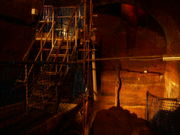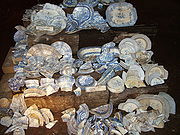
Williamson's tunnels
Encyclopedia

Edge Hill, Liverpool
Edge Hill is a district of Liverpool, England. It is located to the south east of Liverpool city centre, bordered by the city centre, Kensington, Wavertree and Toxteth. Edge Hill University was founded here, but moved to Ormskirk in the 1930s.-History:...
area of Liverpool
Liverpool
Liverpool is a city and metropolitan borough of Merseyside, England, along the eastern side of the Mersey Estuary. It was founded as a borough in 1207 and was granted city status in 1880...
, England, which were built under the direction of the eccentric businessman Joseph Williamson
Joseph Williamson (philanthropist)
Joseph Williamson was an eccentric, businessman, property owner, and a philanthropist who is best known for the tunnels which were constructed under his direction in the Edge Hill area of Liverpool, England...
between the early 19th century and 1840. They remained derelict, filled with rubble and refuse, until archaeological investigations were carried out in 1995. Since then excavations have been carried out and part of the labyrinth of tunnels has been opened to the public as a heritage centre.
History
In 1805 Joseph Williamson acquired an area of land in Mason Street, Edge Hill, Liverpool, which was then a largely undeveloped outcrop of sandstoneSandstone
Sandstone is a sedimentary rock composed mainly of sand-sized minerals or rock grains.Most sandstone is composed of quartz and/or feldspar because these are the most common minerals in the Earth's crust. Like sand, sandstone may be any colour, but the most common colours are tan, brown, yellow,...
with a scattering of scars from small-scale quarrying. He started to build houses on the site. These houses were eccentric in design "of the strangest description" without any rational plans. The ground behind the houses dropped sharply and in order to provide large gardens, which was the fashion at the time, Williamson built arches over some of the quarrying, and arched terraces over which the gardens could be extended. When these were complete he continued to employ his workmen, sometimes to carry out apparently pointless tasks, such as moving rubble from one place to another, then back again. His major project was to build a labyrinth of brick-arched tunnels in various directions and over various lengths within the sandstone. This tunnel-building continued until Williamson's death in 1840. In August 1867 the Liverpool Porcupine described the tunnels as being "a great nuisance" because drains ran straight into them, in one place creating a cess pool
Cesspit
A cesspit, or cesspool is a pit, conservancy tank, or covered cistern, which can be used to dispose of urine and feces, and more generally of all sewage and refuse. It is a more antiquated solution than a sewer system. Traditionally, it was a deep cylindrical chamber dug into the earth, having...
full of offensive water 15 feet (5 m) deep, and they were being used for dumping refuse, including down chutes built into the buildings above for the purpose.
Investigations and archaeology
In the early 20th century soldiers from the West Lancashire Territorial Forces Association explored the tunnels. Their drill hallDrill hall
A drill hall is a place such as a building or a hangar where soldiers practice and perform military drill. In the United Kingdom and Commonwealth, the term was also used for the whole headquarters building of a military reserve unit, which usually incorporated such a hall...
in Mason Street stood on top of one of the tunnels. In 1907 the Association produced a map of the tunnels, which was incomplete because many of them were filled with rubble. The map also showed the course of the London and North Western Railway
London and North Western Railway
The London and North Western Railway was a British railway company between 1846 and 1922. It was created by the merger of three companies – the Grand Junction Railway, the London and Birmingham Railway and the Manchester and Birmingham Railway...
cutting between Edge Hill
Edge Hill railway station
Edge Hill railway station serves the district of Edge Hill in Liverpool, England.There have been two stations of that name. The first stood a short distance south-west of the present station and its remains are still visible, although the site is not open to the public.Edge Hill is the first...
and Lime Street
Liverpool Lime Street railway station
Liverpool Lime Street is a railway station serving the city centre of Liverpool, England. The station lies on a branch of the West Coast Main Line from London Euston, and on the Wirral Line of the Merseyrail network...
stations which ran through the area of the Williamson tunnels. In 1995 a geology
Geology
Geology is the science comprising the study of solid Earth, the rocks of which it is composed, and the processes by which it evolves. Geology gives insight into the history of the Earth, as it provides the primary evidence for plate tectonics, the evolutionary history of life, and past climates...
student from Liverpool University
University of Liverpool
The University of Liverpool is a teaching and research university in the city of Liverpool, England. It is a member of the Russell Group of large research-intensive universities and the N8 Group for research collaboration. Founded in 1881 , it is also one of the six original "red brick" civic...
carried out a micro-gravity
Gravimetry
Gravimetry is the measurement of the strength of a gravitational field. Gravimetry may be used when either the magnitude of gravitational field or the properties of matter responsible for its creation are of interest...
survey of the site. Some of his findings were ambiguous because of the rubble filling the tunnels and not all of his findings corresponded with those of the Forces Association. Later that year a professional firm, Parkman, carried out a survey on behalf of the Joseph Williamson Society. Since then further investigations and excavations have been carried out.
The tunnels

Liverpool Metropolitan Cathedral
The Metropolitan Cathedral Church of Christ the King is a Roman Catholic cathedral in Liverpool, Merseyside, England. The cathedral is the seat of the Archbishop of Liverpool and the Roman Catholic Archdiocese of Liverpool. The Metropolitan Cathedral is one of two cathedrals in the city...
in a rectangle bordered by Mason Street, Grinfield Street, Smithdown Lane and Paddington. Their full extent is not known and many of them are still blocked by rubble. They vary in size from the "banqueting hall", which is about 70 feet (21 m) long, between 20 feet (6 m) and 25 feet (8 m) wide and 20 feet (6 m) high, while the smaller tunnels are 4 feet (1 m) wide and 6 feet (2 m) high.
Purpose of the tunnels
The reasons for building the tunnels have been widely discussed. According to Stonehouse, Williamson was secretive about his motives. This has led to speculation that he was a member of an extremist religious sect fearing that the end of the world was near and that the tunnels were built to provide refuge for himself and his friends. Williamson's own explanation was reputed to be that his workers "all received a weekly wage and were thus enabled to enjoy the blessing of charity without the attendant curse of stifled self respect", his prime motive being "the employment of the poor".The Joseph Williamson Society and Heritage centre

Limited company
A limited company is a company in which the liability of the members or subscribers of the company is limited to what they have invested or guaranteed to the company. Limited companies may be limited by shares or by guarantee. And the former of these, a limited company limited by shares, may be...
in 1996 and acquired charitable status
Charitable organization
A charitable organization is a type of non-profit organization . It differs from other types of NPOs in that it centers on philanthropic goals A charitable organization is a type of non-profit organization (NPO). It differs from other types of NPOs in that it centers on philanthropic goals A...
in 1997. Its aim is to promote interest in the life and philanthropic achievements of Joseph Williamson and takes the form of talks, tours, publications and educational visits. In autumn 2002, after much excavation, removal of rubble and renovation, one of the three sections of the site, the Stable Yard section, was opened to the public as the Williamson Tunnels Heritage Centre under the trusteeship of the Joseph Williamson Society. Visitors are taken on a guided tour which includes the south tunnel and the double tunnel and various artefacts are on view including some of the items which have been uncovered in the excavations. A programme of events and entertainments is organised on the site. The entry to the heritage centre was formerly part of the Lord Mayor's Stable Yard
The Old Stableyard, Liverpool
The Old Stableyard is a brownfield site located on Smithdown Lane in the Edge Hill area of Liverpool, England. It was once one of the main stableyards for Liverpool Corporation, but is now a development site and party redeveloped as the location of The Williamson Tunnels Heritage...
which closed in 1993.
The stable became the home for a horse again when Pop arrived in 2003.
The Friends of Williamson's Tunnels
The Friends of Williamson's Tunnels were formed in 1996 and are a group of enthusiasts distinct from the Heritage Centre whose aim'To advance the education of the general public in all matters relating to Joseph Williamson in particular to preserve... the works and any associated structures either above or below ground that can be accessed from the tunnel entrance at Williamson Student village, No 1 Paddington, Edge Hill'. It received charitable status in 2001. They do not directly fund the Williamson Tunnels Heritage Centre.

